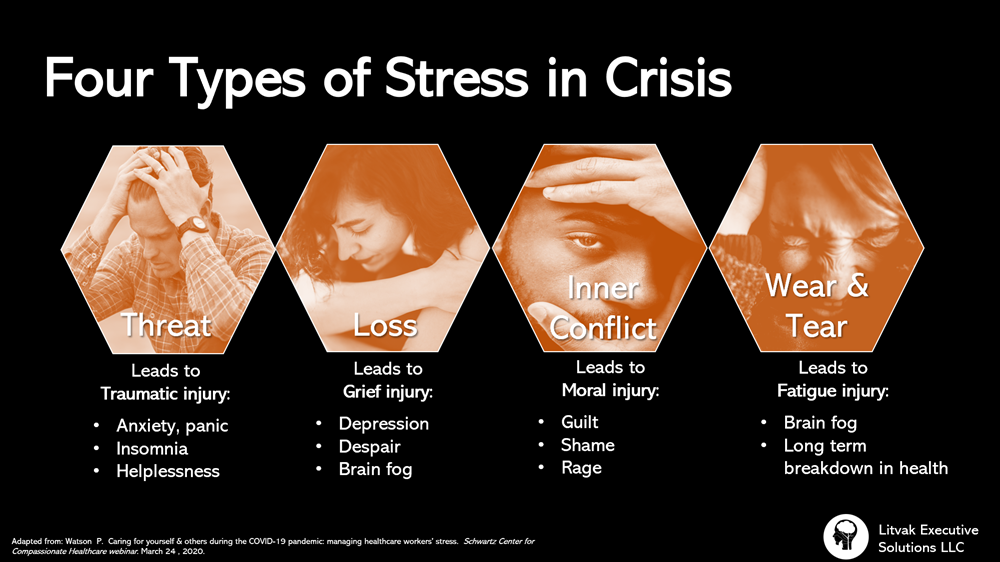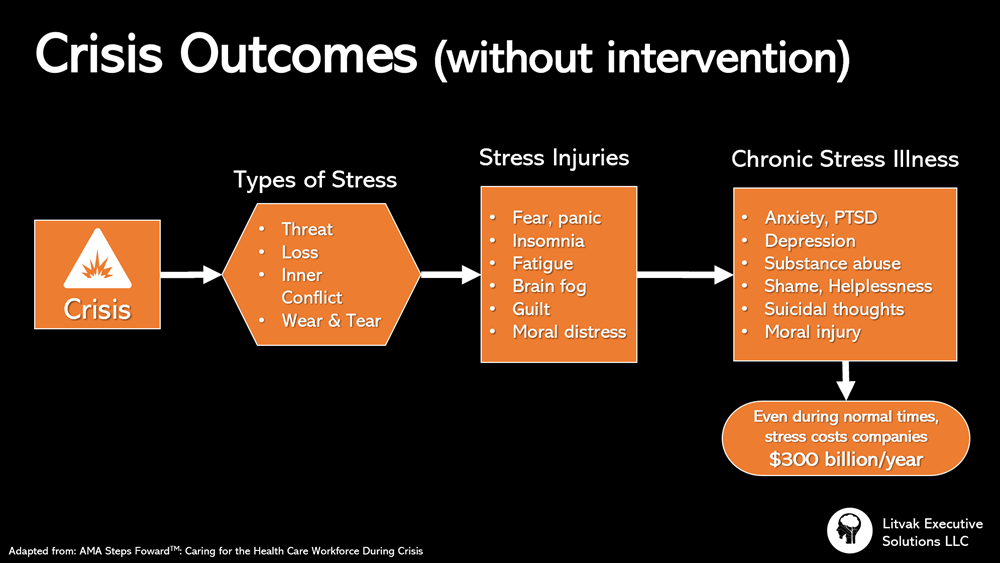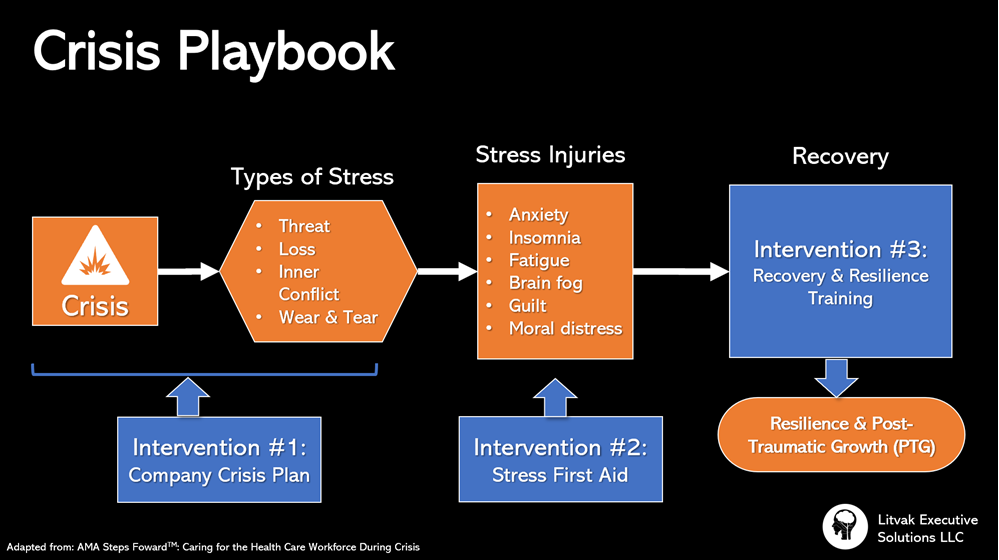In collaboration with the Schwartz Center for Compassionate Healthcare in Boston, Dr. Patricia Watson recently gave a webinar on how to care for yourself and others during the COVID-19 pandemic. In this webinar, she identified four types of stress that often come with crisis:

Illustration by Pamela Coburn-Litvak
We Feel Threatened
The first involves direct, physical threats to our own health and/or that of our families and loved ones.
Being caught up in a global pandemic certainly qualifies. But even before COVID-19, this type of physical stress was more common than you might think.
In a recent survey by the World Health Organization of nearly 70,000 individuals from 24 countries, two-thirds reported experiencing at least one traumatic event such as witnessing death or serious injury, having a loved one die unexpectedly, or having a life-threatening injury or illness. Over a third of those surveyed reported having had four or more such events over their lifetimes.
In a follow-up study of the same individuals, the unexpected death of a loved one was one of the most common types of trauma reported. In the COVID-19 era, I can only imagine that these numbers have climbed even higher.
Trauma is a powerful thing. It has the power to knock our emotions off kilter, propelling us into dark corners of panic, paranoia, and fear. If not checked, traumatic injuries are known to increase the risk of serious mental disorders like PTSD.
We Experience Loss
The second involves the loss of someone or something deeply meaningful to us.
Research tells us that there are two aspects of stress that amplify its impact: 1) unpredictability and 2) lack of control. These explain the devastating impact of loss: we often don’t see it coming and feel powerless to stop it.
Death is the most obvious, but far from the only, kind of loss during crisis times. Consider these others:
- loss of patients or clients;
- loss of colleagues;
- loss of an important work role, resulting in a loss of identity;
- shifts in work responsibility due to crisis conditions;
- loss of control over work conditions;
- loss of safety (in other words, trauma; see above);
- loss of cherished beliefs or values (in other words, inner conflict; see below);
Our natural response to loss is grief. Losing people, things, or valued parts of one’s own identity and values during a crisis can all result in grief injury, characterized by despair and a sense of helplessness.
It takes time and care to overcome grief – both of which can be hard to come by in the middle of a crisis. If left unchecked, grief can devolve into clinical depression, substance abuse, and suicidal thoughts.
We Have Inner Conflict
Sometimes we experience conflict between our own values and what we can actually do at work.
This type of stress has been mostly studied in soldiers who witnessed or were forced to take part in war crimes that violated their personal beliefs and moral code. The psychological damage that follows is termed a moral injury. It results in a complex collection of negative feelings including guilt (e.g. “I did a bad thing”), shame (e.g. “I am a bad person”), helplessness, self-condemnation, outrage, and sorrow.
We now know that moral injury haunts healthcare workers who, based on shortages of vital medical supplies like ventilators, have been forced to choose who would live and who would die on their COVID-19 wards. Inner conflicts can well up even as a healthcare worker chooses to go to work each day – they cannot shake the fear that, in serving their patients, they will put their own families at risk. Such choices violate the long-standing and core clinical oath coined by Greek physician Hippocrates: “Do no harm.”
We Get Worn Down
We can all probably relate to the fourth type: feeling worn down by relentless work and demands without time for rest and recovery.
The technical term for this wear and tear is allostatic load – and boy, does it feel like a heavy load. Just as our bodies will eventually collapse if forced to go too far or too long, so will the mind. Fatigue injury can result in brain fog, poor concentration, and apathy, and burnout. And workplace burnout rates have at least doubled since COVID-19 began.
Even during normal times, the costs of stress can be prohibitive. According to statistics gathered by the American Institute of Stress, workplace stress costs companies upwards of $300 billion a year.

Illustration by Pamela Coburn-Litvak
How to Care for Your Workers During a Crisis
Business managers and owners across many industries have faced unprecedented times over the last several months. While many are now in the process of recovery, it’s important to understand and mitigate the long-term impacts of crisis on workplace morale. Providing little or no support will inevitably increase the risk of stress-related injuries, including burnout.
But the right kind of support can stave off the worst outcomes – e.g. anxiety, depression, PTSD, substance abuse, and suicidal thoughts – and boost the chances that workers can come out of crisis stronger and more resilient than they went in.
Learning through trauma is called post-traumatic growth (PTG). And if there is one industry that is working feverishly to support PTG right now, it’s healthcare.
Doctors, nurses, and therapists have been battling the frontlines of COVID-19 for the rest of us for close to a year now. They are our heroes. They deserve our eternal gratitude for having saved thousands – more likely millions – of lives worldwide.
But they are also carrying a huge stress burden right now, and they need all the support their institutions can give them.
For this reason, agencies like the American Medical Association have put together guidelines and playbooks to use in crisis times. One recent playbook, Caring for the Health Care Workforce During Crisis, is part of the AMA’s Steps Forward program and is written by physician leaders Tait Shanafelt, Jonathan Ripp, Marie Brown, and Christine Sinsky.

Illustration by Pamela Coburn-Litvak
This playbook will serve as the foundation for the rest of this article series. Starting in part 2, we will take a deeper dive into three types of crisis intervention that can prevent crisis-related injury to workers’ physical and mental health and promote resilience and post-traumatic growth.


[…] part 1 of this series, we learned about four types of stress we can face during times of crisis. If left unchecked, these […]